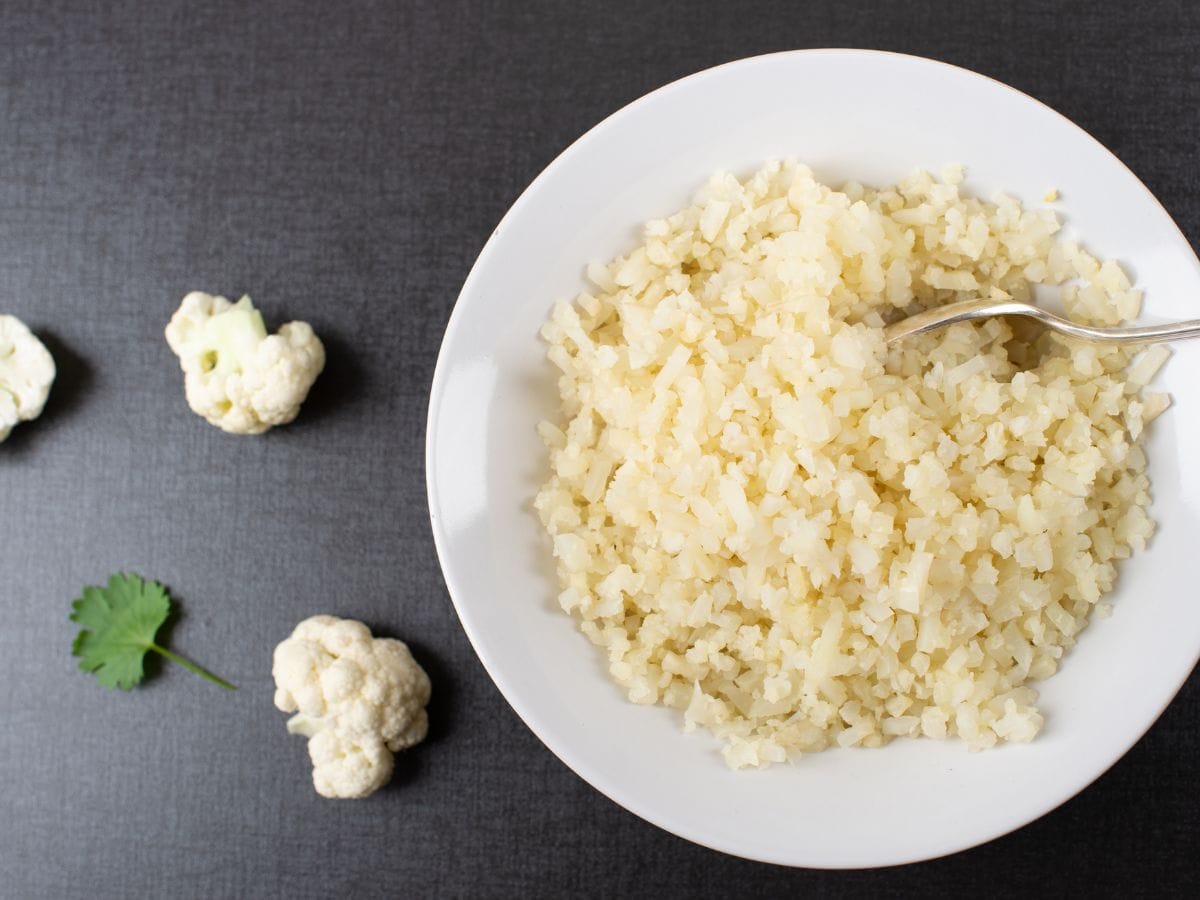Primal Edge Health participates in the Amazon Services LLC Associates Program and other affiliate programs and therefore, may collect a share of sales or other compensation from the links on this page. This comes at no additional cost to you, and all the prices and availability are accurate at the time of publishing.
Frozen cauliflower rice is a healthy and convenient option for those looking for a quick and easy way to add more vegetables to their diet. It is simply raw cauliflower that has been processed into small, rice-like pieces and then frozen.
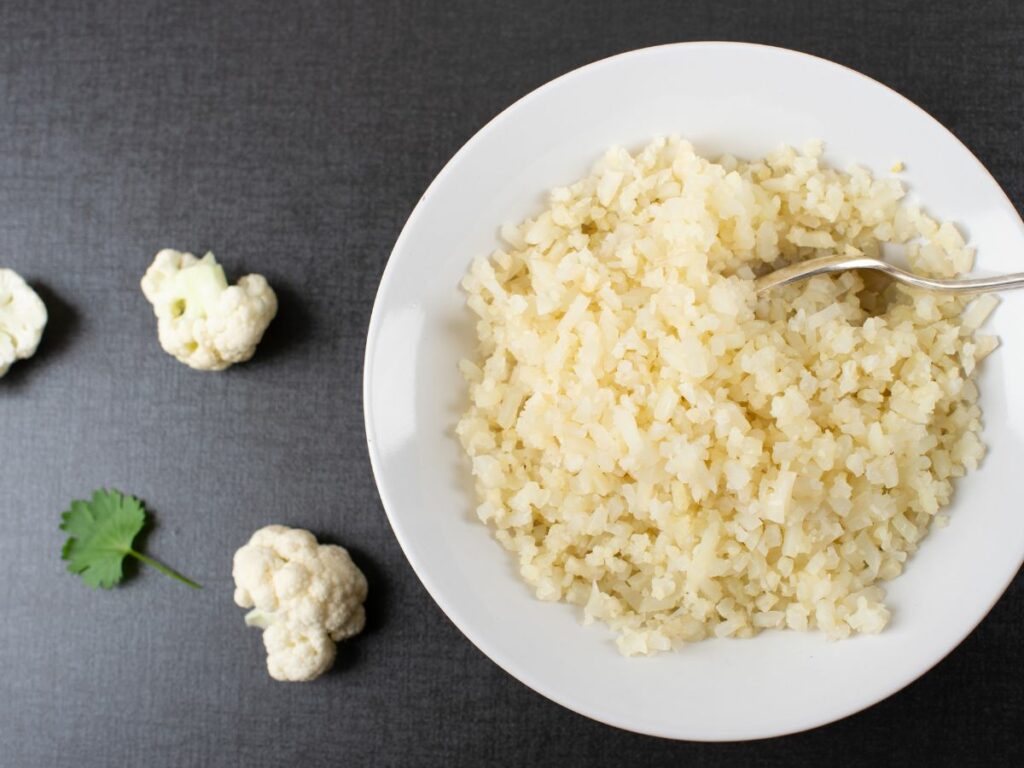
You may have purchased frozen cauliflower rice because it’s budget-friendly, has a longer shelf life than fresh cauliflower, and stores well. But months have passed, and now you have no idea how to use it.
Here are a few reasons why you should pull that frozen cauliflower rice out of your freezer:
- Convenience: Frozen cauliflower rice is highly convenient since it is pre-cut and ready to use straight out of the bag. It saves you the time and effort of chopping a head of cauliflower yourself.
- Nutritious: Cauliflower is a nutrient-dense vegetable that is low in calories but high in fiber, vitamins, and minerals. According to USDA FoodData Central, it is a source of vitamin C, vitamin K, folate, and potassium. Cauliflower is also a good source of fiber, which can help keep you feeling full and satisfied. Replacing traditional rice with cauliflower rice can help you increase your vegetable intake and reduce your calorie intake at the same time.
- Low-carb: Frozen cauliflower rice is an ideal choice if you’re looking for a keto or low-carb alternative to traditional rice. It’s lower in calories and carbohydrates than rice and makes a suitable keto substitution.
- Versatile: Frozen cauliflower rice is incredibly versatile. You can use it as a base for stir-fries, a substitute for sushi rolls, or a low-carb alternative to traditional rice in bowls and salads.
“I love to keep a bag of frozen cauliflower rice in my freezer for times I want a quick low-carb alternative to the rice my family is having for dinner. It’s so easy to heat it up while I’m cooking the rest of the dinner, and it really is a great stand-in for regular rice as far as pairing well with a lot of different flavors and serving as a base for saucy dishes.”
— Robin Donovan, All Ways Delicious
How To Cook Frozen Cauliflower Rice
Choose your favorite method and follow the simple step-by-step process.
Microwave Method (Non-Steamable):
- Remove the frozen cauliflower rice from the freezer and place it into a microwave-safe dish.
- Cover the dish with a microwave-safe lid or plastic wrap, leaving a small vent to allow steam to escape.
- Microwave on high for four to six minutes, stirring halfway through, until the cauliflower rice is heated through and tender.
- Let it sit for one to two minutes before removing it from the microwave.
Microwave Method (Steamable):
- Place the unopened bag of steamable frozen cauliflower rice in the microwave.
- Make sure that the bag is placed in the proper position so that it can vent while cooking by following the instructions on the packaging.
- Microwave the bag for the time listed on the packaging, for instance, on high for five to six minutes.
- Carefully remove the bag from the microwave (it will be hot) and let it cool for at least one minute before carefully cutting it open with scissors.
Stovetop Method:
- Heat a non-stick skillet over medium-high heat.
- Add a small amount of olive oil to the pan and allow it to heat up.
- Add the frozen cauliflower rice to the skillet and stir to combine. You may need to add some water to the pan (check the packaging to confirm).
- Cook for five to seven minutes, stirring occasionally, until the cauliflower rice is tender and heated through before removing it from the heat.
Note: The cooking time may vary depending on the brand and amount of frozen cauliflower rice you use. Referring to the package instructions for cooking times and temperatures is always a good idea.
Do You Have to Wash Frozen Cauliflower Rice?
No, you do not have to wash frozen cauliflower rice before cooking it (and likely should not wash it first). Frozen cauliflower rice has already been processed and cleaned before it was frozen, and most brands require that you cook the frozen cauliflower rice right from its frozen state.
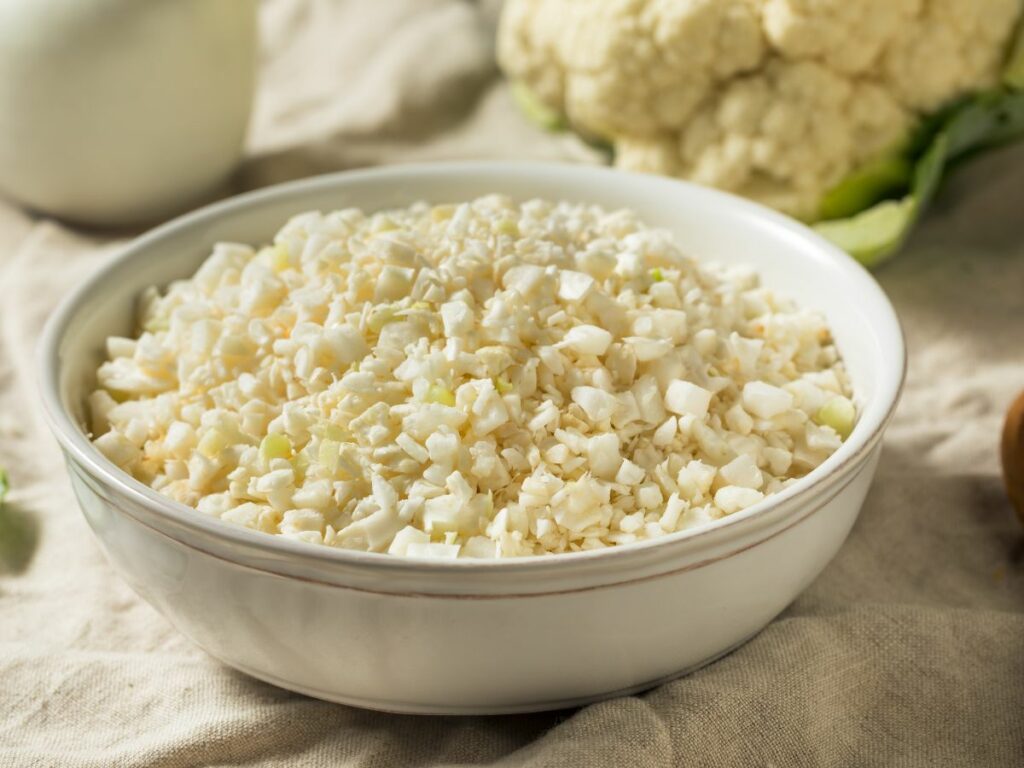
Is Frozen Cauliflower Already Cooked?
Usually, frozen cauliflower rice still needs to be fully cooked. It is typically only blanched before being frozen, which helps preserve its quality and nutrients.
The cauliflower rice is briefly boiled or steamed to cook partially and then quickly cooled to stop the cooking process. This blanching helps preserve the cauliflower’s color, texture, and flavor while also reducing the growth of harmful bacteria.
Should I Thaw Frozen Cauliflower Rice Before Cooking?
Most store-bought brands of frozen cauliflower rice should not be thawed before cooking and should be cooked straight from frozen.
How Do You Make Frozen Cauliflower Rice Not Soggy?
Cook it in small batches: If you’re cooking it on the stovetop, cook the frozen cauliflower rice in small batches. Cooking too much at once can produce excess moisture and lead to soggy cauliflower rice.
Don’t overcook it: Overcooking cauliflower rice can also lead to a soggy texture. Follow the instructions on the package and cook the cauliflower rice only until it’s tender, yet still has some texture.
Use high heat: When cooking cauliflower rice on the stovetop, use high heat to cook it quickly and evaporate any excess moisture. The high heat will help keep the cauliflower rice from becoming too soft and soggy.
Why Has My Frozen Cauliflower Rice Turned Grey?
Natural discoloration: Over time, frozen cauliflower rice can naturally start to lose its bright white color and turn a slightly greyish color. This loss of color is due to natural oxidation, which can happen when the cauliflower is exposed to air.
Freezer burn: If the cauliflower rice has been in the freezer for an extended period or wasn’t stored correctly, it can develop freezer burn. Freezer burn occurs when the food’s surface becomes dehydrated, and ice crystals form, which can cause the cauliflower to turn grey and create a tough texture.
Spoilage: If the cauliflower rice has been in the freezer for too long, it may spoil and develop mold or other bacteria that can cause it to turn grey, have a foul odor, and have a slimy texture.
Frozen cauliflower rice can spoil like any other food, so follow proper food storage and handling practices. If the cauliflower rice looks or smells off, it’s best to discard it to avoid the risk of foodborne illness.
What Is The Shelf Life of Frozen Cauliflower Rice?
Generally, frozen cauliflower rice can last for up to two months in the freezer. However, the quality of pre-packaged frozen cauliflower rice may deteriorate after several months in the freezer.
It may lose some of its flavor and texture the longer it’s frozen. To ensure the highest quality, use frozen cauliflower rice within one month of purchasing.
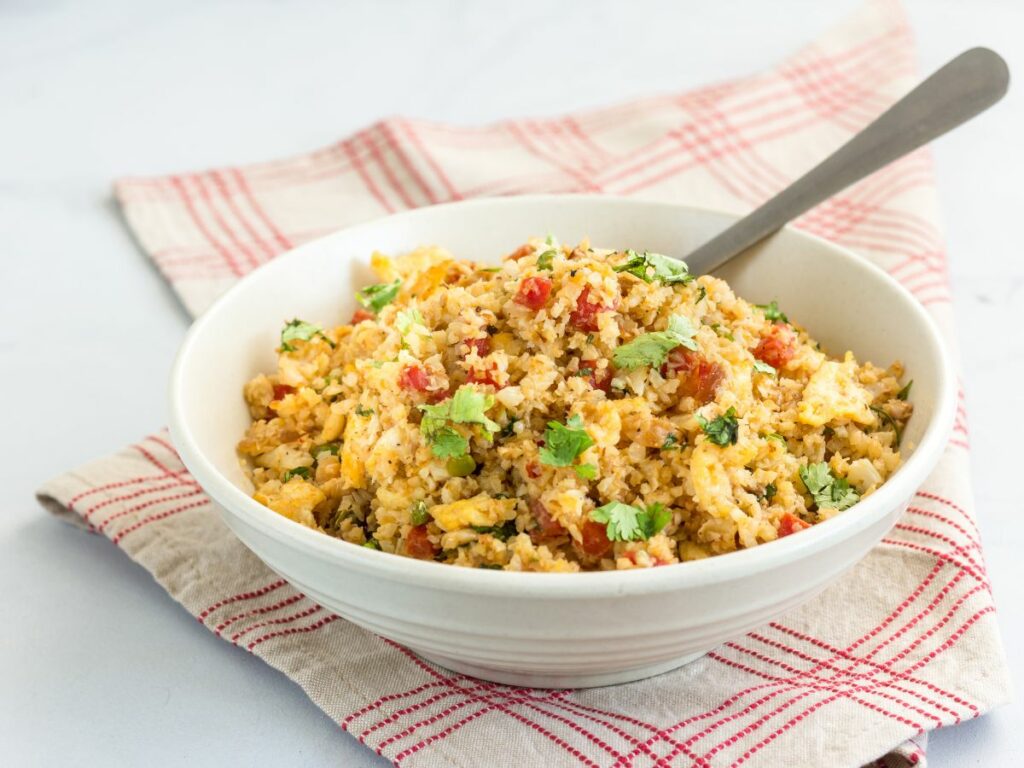
Ways To Use Frozen Cauliflower Rice
Skip homemade cauliflower rice and use frozen instead for these delicious dishes.
Cauliflower Fried Rice: Use frozen cauliflower rice as a base for a healthier version of this popular takeout dish.
Cauliflower Rice Sushi Roll: Use cauliflower rice as a substitute for traditional sushi rice to make a healthier sushi roll. Don’t forget the seaweed.
Cauliflower Rice Mash: Cook the cauliflower rice from frozen, pour it into a food processor with some heavy cream, butter, and seasonings, and pulse until smooth and creamy to yield a lower-carb alternative to mashed potatoes.
Cauliflower Rice Stir Fry: Toss cauliflower rice with your favorite veggies, protein, and sauce for a quick and easy stir fry.
Cauliflower Rice Soup: Use cauliflower rice as a creamy and flavorful soup base.
Cauliflower Rice Salad: Mix the cauliflower rice with fresh herbs, cooked vegetables, a protein like chicken or salmon, and a dressing for a refreshing salad.
Cauliflower Rice Tacos: Use cauliflower rice as a filling for tacos, along with your favorite toppings. The same goes for tostadas or a taco skillet.
Cauliflower Rice Stuffed Peppers: Stuff bell peppers with cauliflower rice, protein, and cheese for a tasty, low-carb meal.
Cauliflower Rice Risotto: Use cauliflower rice instead of traditional arborio rice to make a creamy and delicious cauliflower risotto.
Cauliflower Rice Casserole: Prepare your frozen cauliflower rice with cheese and beef like this cheesy beef casserole for a filling dinner.
Cauliflower Rice Shepherd’s Pie: Layer the cauliflower rice with ground beef, veggies, and mashed potatoes or cauliflower for a hearty and delicious meal faster than a slow cooker shepherd’s pie.
Cauliflower Rice Burritos: Use cauliflower rice as a burrito filling, along with cheese, avocado salsa, and low-carb tortilla.
Easy Cauliflower Rice Bowl Ideas
Cauliflower Rice Bowl: Top the cauliflower rice with your favorite protein, veggies, and sauce for a delicious and nutritious meal, like this Meal Prep Saucy Salmon.
Cauliflower Rice Breakfast Bowl: Top the cauliflower rice with eggs, bacon, avocado, and salsa for a filling and delicious breakfast.
Cauliflower Rice Burrito Bowl: Use the cauliflower rice as a base for a burrito bowl, along with your favorite toppings.
Cauliflower Rice Sushi Bowls: Mix the cauliflower rice with avocado, cucumber, soy sauce, and your favorite sushi toppings for a quick and healthy sushi bowl.
FAQs
Frozen cauliflower rice is just as healthy as fresh vegetables. Frozen vegetables are also processed at their prime. Thus, vital nutrients are maintained even after sitting in the freezer for weeks.
Regarding its nutrition, cauliflower rice provides essential nutrients like Vitamins C and K. It is also rich in fiber, potentially promoting good digestive health. Additionally, it contains antioxidants that may have anti-inflammatory properties.
Rice is high in carbohydrates and calories. This means it will fill you up without providing you with other nutrients that your body needs. Cauliflower rice, on the other hand, offers more antioxidants as it reduces carbohydrates and calories. With this, you can save room for other nutrient-dense food.
One is not better than the other when it comes to quality. However, frozen cauliflower is easier and quicker to cook since it’s already prepared. It’s ideal for busy home cooks.
Frozen cauliflower doesn’t have preservatives. Freezing is a natural process to preserve food and doesn’t require added preservatives. So, you can be confident that you’re eating a healthy rice alternative.
Yes, it is safe to eat frozen cauliflower. Frozen cauliflowers are frozen during their prime without additional preservatives. Use good sense to make sure that it’s not spoiled. Examine its color, smell, and texture first before you cook it. You can also check the best-before date to be sure.
Buying frozen cauliflower rice from stores is affordable and convenient. But, if you have more time and are on a budget, you can make one at home. All you need is a food processor with an S blade.
Make sure to cut the head of the cauliflower into smaller sizes and toss them in the food processor. After that, portion out your riced cauliflower into freezer-safe containers and pop them into your freezer.
Final Thoughts
Frozen cauliflower rice is a healthy and convenient option for busy people who want to eat well. It is a great way to increase your vegetable intake and reduce your calorie intake while saving you time and effort in the kitchen.
So, open up your freezer, pull out that bag of frozen cauliflower rice, cook it up, and dig in.
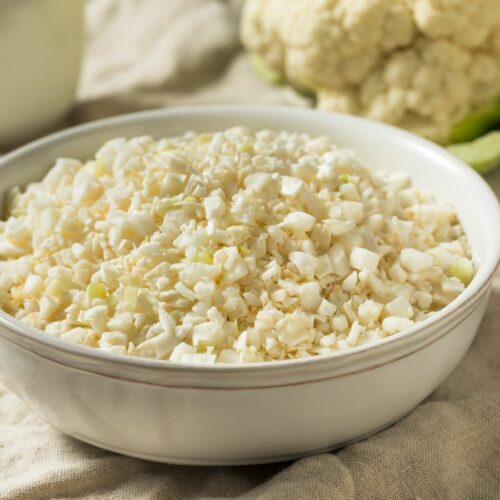
How to Cook Frozen Cauliflower Rice on the Stove
Master the art of stovetop cauliflower rice with our simple step-by-step guide. Transforming plain cauliflower into a flavorful, low-carb delight has never been easier. Cook up a storm in minutes and elevate your dishes with this versatile, keto-friendly alternative.
- 1 (16-ounce) bag frozen cauliflower rice
Prevent your screen from going dark
-
Heat a non-stick skillet over medium-high heat.
-
Add a small amount of olive oil to the pan and allow it to heat up.
-
Add the frozen cauliflower rice to the skillet and stir to combine. You may need to add some water to the pan (check the package to confirm).
-
Cook for five to seven minutes, stirring occasionally, until the cauliflower rice is tender and heated through before removing it from the heat.
Note: The cooking time may vary depending on the brand and amount of frozen cauliflower rice you use. Referring to the package instructions for cooking times and temperatures is always a good idea.
Serving: 4ouncesCalories: 28kcalCarbohydrates: 6gProtein: 2gFat: 0.3gSaturated Fat: 0.1gSodium: 34mgFiber: 2gNet Carbohydrates: 4g
To obtain the most accurate representation of the nutritional information in a given recipe, please calculate the nutritional information with the actual ingredients and amounts used, using your preferred nutrition calculator. Under no circumstances shall the this website and the author be responsible for any loss or damage resulting for your reliance on the given nutritional information.
This article originally appeared on Food Drink Life.





